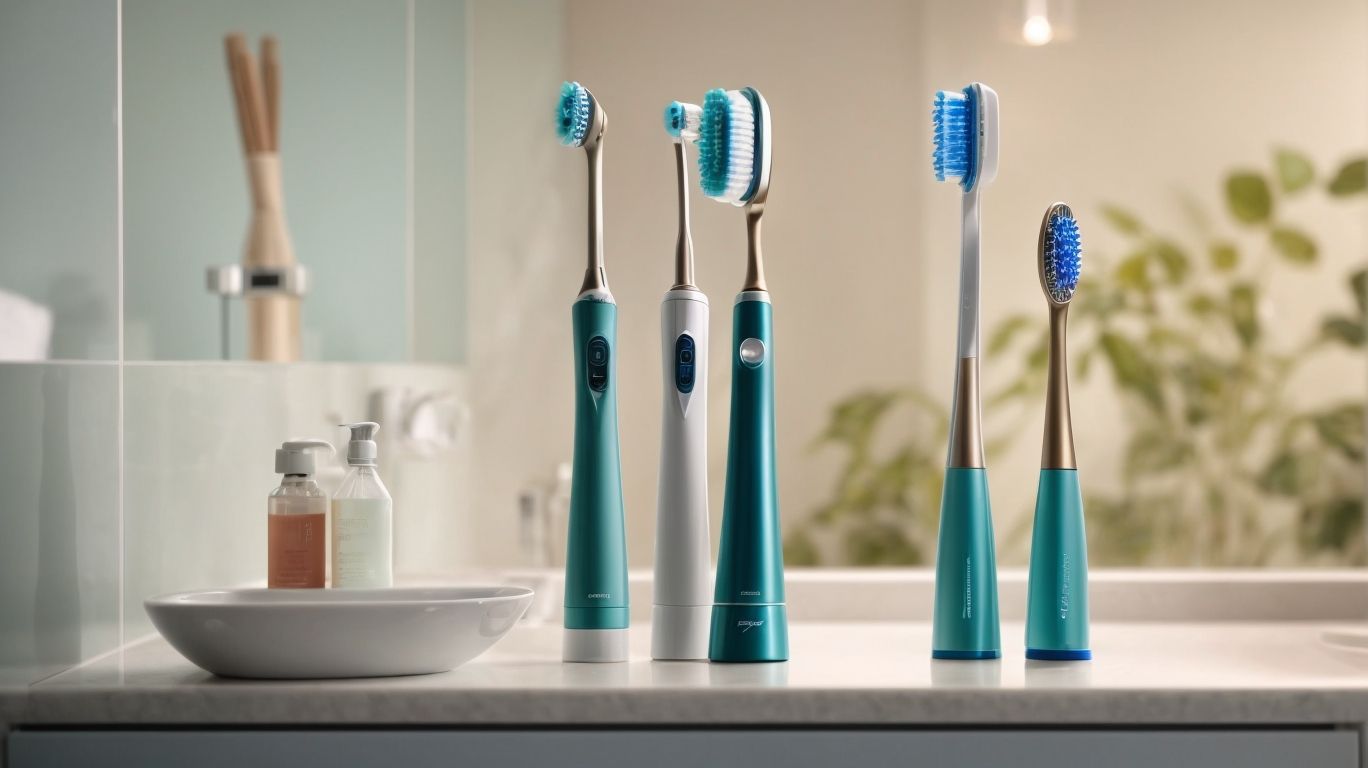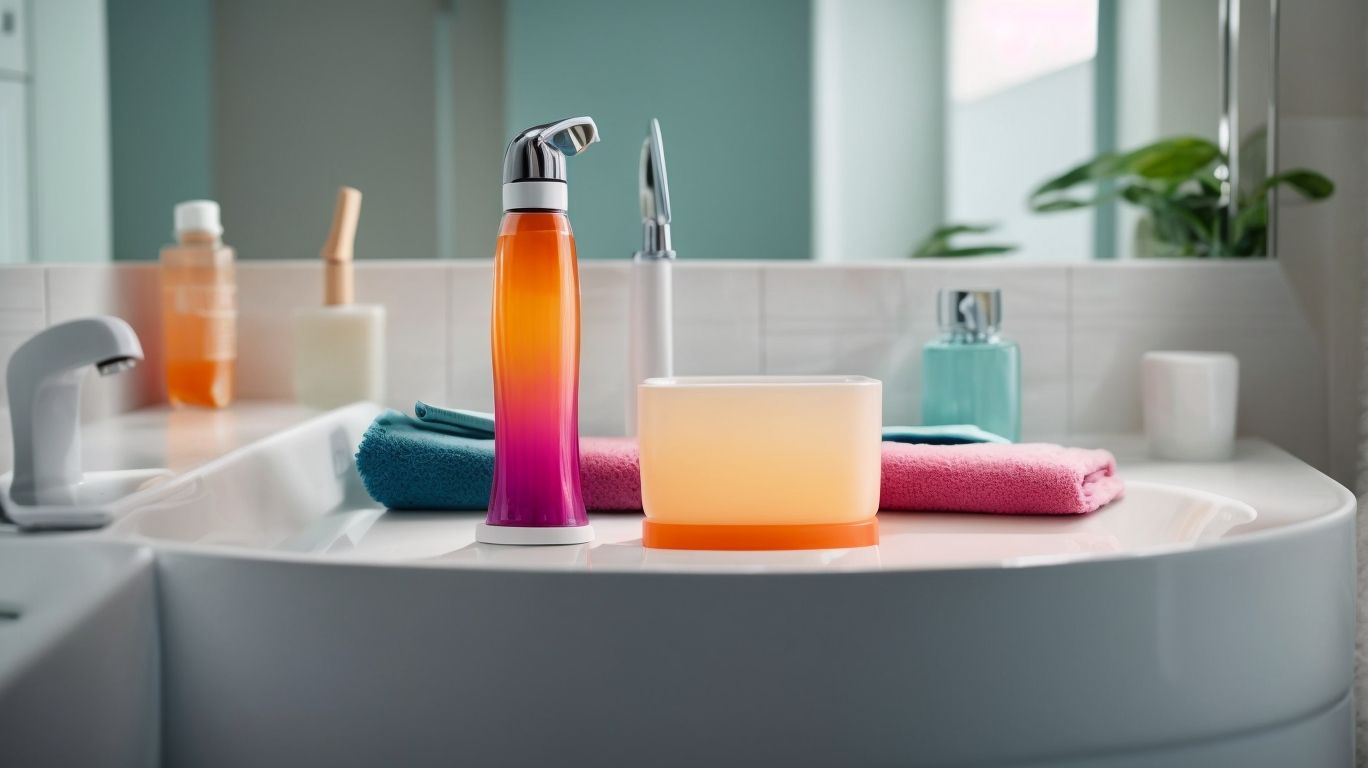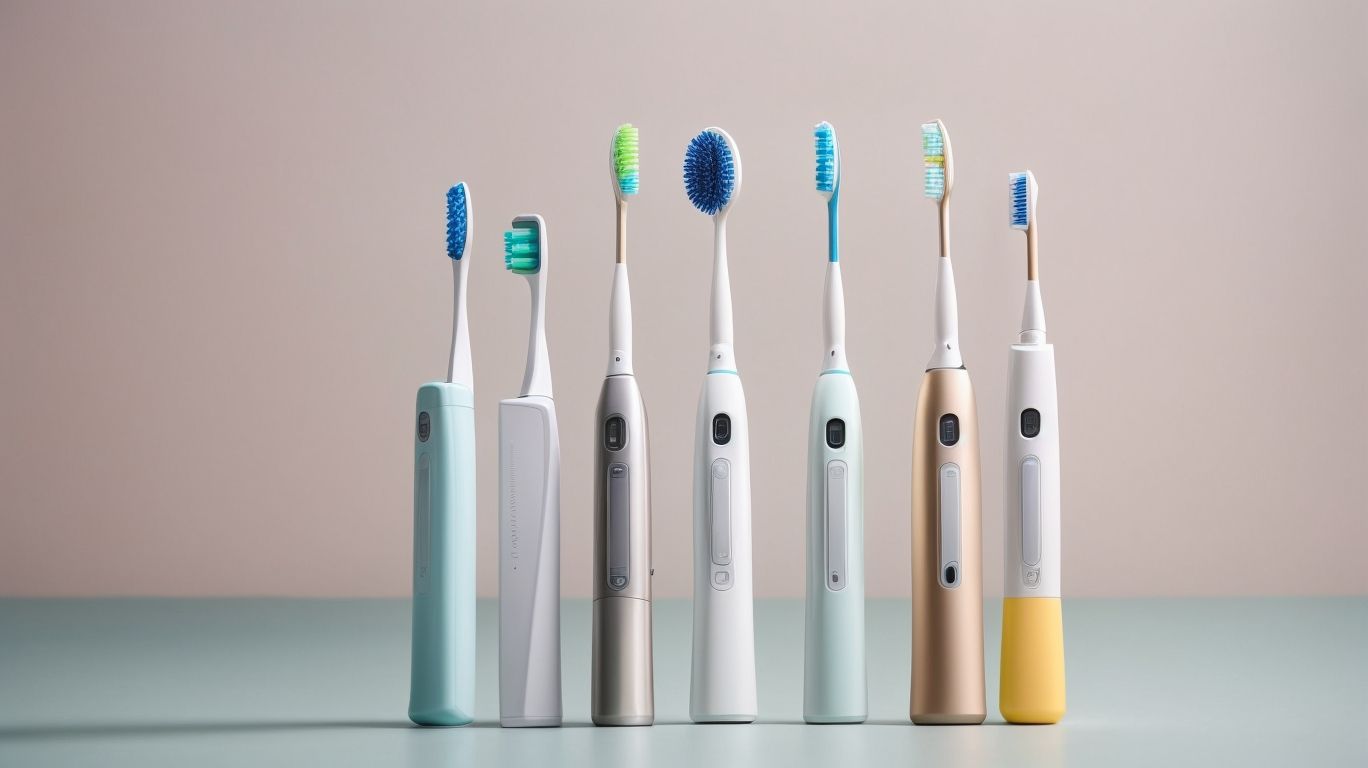.jpg)
Electric toothbrushes and manual toothbrushes are both popular choices for maintaining oral hygiene, but which one is better? In this comparison, we will explore the advantages and disadvantages of each to help you make an informed decision.
Electric Toothbrush: Advantages and Disadvantages
Electric toothbrushes offer several advantages in oral care. Firstly, they provide enhanced plaque removal compared to manual toothbrushes. The oscillating or rotating brush heads of electric toothbrushes can reach areas that are harder to clean manually. Secondly, electric toothbrushes are easier to use, especially for people with limited dexterity or physical conditions that make brushing difficult. Finally, most electric toothbrushes come with built-in timers, ensuring that you brush for the recommended 2 minutes.
However, electric toothbrushes also have their drawbacks. One disadvantage is the higher cost compared to manual toothbrushes. Electric toothbrushes require charging, which may be inconvenient for travel. Their bulkier design can also make them less portable.
Manual Toothbrush: Advantages and Disadvantages
Manual toothbrushes have been the traditional choice for oral care. They are cost-effective, widely available, and come in a variety of options to cater to individual preferences. Manual toothbrushes are also portable, making them convenient for travel.
On the other hand, manual toothbrushes require proper brushing technique to effectively remove plaque. Without using the correct technique, manual brushing may not be as thorough as electric toothbrushes. This can be a disadvantage, especially for individuals with limited manual dexterity or difficulty with proper brushing motions.
Which Toothbrush Should You Use?
When choosing between an electric toothbrush and a manual toothbrush, several factors should be considered. Personal preference plays a significant role. Some people may prefer the convenience and advanced features of an electric toothbrush, while others may prefer the simplicity and familiarity of a manual toothbrush. Your oral health condition and any specific dental recommendations should be considered. Lastly, your manual dexterity and ability to effectively use a manual toothbrush can impact your decision.
Tip for Proper Toothbrushing Technique
Regardless of the type of toothbrush you choose, it is essential to maintain proper brushing technique. Brushing for at least 2 minutes, using gentle circular motions, and adequately reaching all areas of the mouth are crucial for optimal oral hygiene.
Key takeaways:
- Electric toothbrushes offer enhanced plaque removal and ease of use, making them effective in maintaining oral hygiene.
- Manual toothbrushes are cost-effective, portable, and offer a wide variety of options, making them convenient for travel.
- The choice between electric and manual toothbrush depends on personal preference, oral health condition, and manual dexterity.
Electric Toothbrush vs Manual Toothbrush: Which is Better?

Photo Credits: Feelsgoodtosmile.Com by Roger Anderson
When deciding between an electric toothbrush and a manual toothbrush, you may be wondering, “Electric Toothbrush vs Manual Toothbrush: Which is Better?” There are several factors to consider to determine which option is better suited for your dental hygiene needs.
- Effectiveness: When it comes to removing plaque and reducing gingivitis, electric toothbrushes are generally more effective compared to manual toothbrushes.
- Convenience: If you have limited dexterity or prefer a hands-free brushing experience, electric toothbrushes require less effort while brushing, making them a great option for you.
- Cost: When considering costs, it’s worth noting that manual toothbrushes are more cost-effective. They have a lower upfront cost and do not require replacement heads or batteries.
- Travel-friendly: If portability is a priority for you, manual toothbrushes are more travel-friendly and ideal for your trips.
- Personal preference: Ultimately, the decision between an electric toothbrush and a manual toothbrush comes down to personal preference and what feels most comfortable for you.
To determine the best option based on your specific oral health needs and preferences, consider consulting with your dentist.
Electric Toothbrush: Advantages and Disadvantages

Photo Credits: Feelsgoodtosmile.Com by Peter Garcia
Discover the pros and cons of electric toothbrushes as we explore their advantages and disadvantages. From improved plaque removal to convenient built-in timers, electric toothbrushes offer unique benefits that enhance our dental hygiene routine. They come with certain drawbacks like higher costs and the need for charging. So, let’s dive into the world of electric toothbrushes to understand the trade-offs in this battle of dental prowess.
Advantages of Electric Toothbrush
Selecting an electric toothbrush comes with several advantages of electric toothbrush that contribute to better oral care.
- Enhanced Plaque Removal: Electric toothbrushes often have rotating or oscillating brush heads, making it easier to remove plaque and achieve a thorough clean.
- Ease of Use: With their powered bristles, electric toothbrushes require less physical effort and can be especially helpful for those with limited manual dexterity.
- Built-in Timers: Many electric toothbrushes come with built-in timers that ensure that you brush for the recommended two minutes, promoting proper oral hygiene habits.
Though electric toothbrushes offer numerous benefits, it is essential to consider individual preferences, oral health conditions, and manual dexterity when choosing the most suitable toothbrush.
1. Enhanced Plaque Removal
Enhanced plaque removal is one of the key advantages of using an electric toothbrush. To achieve this, follow these steps:
- Apply a pea-sized amount of toothpaste on the bristles.
- Hold the toothbrush at a slight angle towards your gum line.
- Turn on the electric toothbrush and let it do the work. Simply guide the brush along all surfaces of your teeth.
- Pay extra attention to areas where plaque tends to accumulate, such as the molars and along the gum line.
- Brush for at least two minutes, ensuring you cover all tooth surfaces.
- Rinse your mouth thoroughly with water.
- Clean the brush head properly and store it in a clean, dry place.
True story: Sarah struggled with plaque buildup despite thorough manual brushing. After switching to an electric toothbrush, she experienced an incredible enhancement in plaque removal during her dental checkups.
2. Ease of Use
The ease of use is a crucial aspect to take into account when choosing between an electric toothbrush and a manual toothbrush.
- Electric Toothbrush:
- Effortless brushing with automated bristle movement.
- This option requires less manual dexterity, making it suitable for individuals with arthritis or limited hand mobility.
- Built-in timers ensure brushing for the recommended duration.
- Manual Toothbrush:
- Straightforward to use, with simple brushing motions.
- Portable and travel-friendly for brushing on-the-go.
- Offers a wide variety of options to choose from, including different bristle types and sizes.
When making your decision on which toothbrush to use, take into consideration your personal preference, oral health condition, and manual dexterity.
3. Built-in Timers
When comparing electric toothbrushes and manual toothbrushes, one advantage of electric toothbrushes is the built-in timers they offer. Here are a few reasons why this feature can be beneficial:
- Promotes Proper Brushing Time: Many dentists recommend brushing for at least two minutes. Electric toothbrushes with built-in timers ensure that you brush for the recommended time, helping to effectively remove plaque and maintain oral health.
- Segmented Cleaning: Some electric toothbrushes divide the brushing time into quadrants, signaling when it’s time to move on to a different area of your mouth. This helps ensure you give equal attention to all parts of your teeth.
- Consistency: The timers help you establish a consistent brushing routine, preventing you from cutting the brushing time short or spending too much time in one area.
Pro-tip: If your manual toothbrush doesn’t have a built-in timer, using a separate timer or playing a song for two minutes can be a helpful alternative to ensure you brush for the recommended time.
Disadvantages of Electric Toothbrush
- Electric toothbrushes tend to be more expensive than manual toothbrushes. They often require a larger initial investment and replacement brush heads can also be pricey.
- Electric toothbrushes also have the disadvantage of requiring regular charging, which can be inconvenient if you forget or don’t have access to an outlet.
- Another disadvantage is that electric toothbrushes can be bulky and more difficult to pack when traveling, taking up more space in your luggage.
1. Higher Cost
Electric toothbrushes have a higher cost compared to manual toothbrushes. This higher cost is a result of the advanced features and technology that electric toothbrushes offer. Some electric toothbrushes can be quite expensive, particularly those with additional features such as pressure sensors or Bluetooth connectivity. On the other hand, manual toothbrushes are more affordable and readily available. They provide a wide variety of options regarding bristle types, head sizes, and designs. Although electric toothbrushes may come with a higher price tag, they can offer enhanced plaque removal and ease of use, making them a worthwhile investment for individuals with specific oral health needs.
2. Requires Charging
The fact that electric toothbrushes require charging is a notable disadvantage. Here are some points to consider:
- Convenience: The inconvenience of charging an electric toothbrush can be especially noticeable during travels when access to charging points may be limited.
- Battery life: Desiring longer battery life is understandable, as frequent charging can disrupt the brushing routine.
- Backup option: It is advisable to have a manual toothbrush available as a backup to maintain oral hygiene, especially if the electric toothbrush runs out of charge.
If you prefer the convenience and technology of an electric toothbrush, planning for regular charging and having a backup option on hand can help mitigate the disadvantage.
3. Bulky for Travel
When considering whether to use an electric or manual toothbrush, one disadvantage of electric toothbrushes is that they can be bulky for travel. Here are a few reasons why:
- Size and Weight: Electric toothbrushes are typically larger and heavier than manual toothbrushes, making them less convenient for travel.
- Battery or Charging Needs: Electric toothbrushes require batteries or charging, which can add to the bulkiness and hassle of packing for travel.
- Cases and Accessories: Electric toothbrushes often come with separate cases or accessories, taking up additional space in luggage.
To overcome this issue, consider a compact travel-sized electric toothbrush or opt for a manual toothbrush when traveling. It’s important to maintain good oral hygiene even while on the go.
Manual Toothbrush: Advantages and Disadvantages

Photo Credits: Feelsgoodtosmile.Com by Henry Martin
Explore the world of manual toothbrushes, their unique advantages, and potential drawbacks. Discover the cost-effectiveness and portability that make them travel-friendly options. With a wide variety of choices available, find the perfect fit for your brushing needs. Keep in mind that proper technique is crucial for optimal results, and manual brushes may not provide the same level of effectiveness as their electric counterparts. Let’s dive into the details and make an informed decision for your oral hygiene routine!
Advantages of Manual Toothbrush
Using a manual toothbrush offers several advantages that make it a popular choice for many people:
- – Manual toothbrushes are generally less expensive than electric ones, making them budget-friendly.
- – Manual toothbrushes are lightweight and don’t require charging, making them easy to pack and carry on trips.
- – Manual toothbrushes come in different sizes, bristle types, and designs, allowing you to choose one that suits your preferences and needs.
When deciding which toothbrush to use, consider factors like personal preference, oral health condition, and manual dexterity. Ultimately, the most important thing is to maintain a proper toothbrushing technique and consistently practice good oral hygiene.
1. Cost-Effective
Using a manual toothbrush can be a cost-effective option for maintaining oral hygiene. Here are some reasons why:
- Lower cost: Manual toothbrushes are generally more affordable than electric ones.
- No additional expenses: Manual toothbrushes do not require batteries or charging, saving you money in the long run.
- Easy to replace: Manual toothbrushes need to be replaced every three to four months, but they are inexpensive to replace.
Considering the cost-effectiveness of manual toothbrushes, they are a practical choice for individuals who want to maintain good oral health without breaking the bank. It’s important to keep in mind that personal preferences and oral health conditions may influence the choice of toothbrush. Consult with your dentist to determine the best cost-effective option for you.
2. Portable and Travel Friendly
When it comes to toothbrushes, manual toothbrushes have the advantage of being portable and travel-friendly. Here are some reasons why:
- Convenience: Manual toothbrushes are compact in size, making them portable and travel-friendly. They are easy to carry in your purse, bag, or travel case.
- No charging required: Unlike electric toothbrushes, manual toothbrushes don’t need to be charged, so you don’t have to worry about finding an outlet while traveling. This makes them portable and travel-friendly.
- Variety of options: Manual toothbrushes come in a wide range of styles, sizes, and bristle types, allowing you to choose the one that best suits your needs and preferences. This ensures that you can find a portable and travel-friendly toothbrush that meets your requirements.
If you prioritize portability and convenience, a manual toothbrush is the better choice for you, especially when you’re on the go.
3. Wide Variety of Options
When it comes to manual toothbrushes, there is a plethora of choices available to suit individual preferences.
- Bristle Strength: Manual toothbrushes come in a diverse range of bristle strengths, ranging from soft to medium to hard, allowing users to select based on their comfort and oral health needs.
- Head Size: Manual toothbrushes also offer various head sizes, enabling users to clean specific areas of their mouth with greater precision.
- Grip Handle: Some manual toothbrushes feature ergonomic grips designed for comfortable and easy handling, offering better control during brushing.
- Special Features: Manual toothbrushes may include additional features such as tongue cleaners, gum stimulators, or angled bristles to cater to specific oral care needs.
Ultimately, the extensive range of options available with manual toothbrushes allows individuals to discover one that best suits their personal preferences and oral health needs.
Disadvantages of Manual Toothbrush
Disadvantages of Manual Toothbrush
Using a manual toothbrush may have a few disadvantages to consider:
Requires Proper Technique: With a manual toothbrush, the proper brushing technique is essential to effectively remove plaque and prevent gum disease.
May Not Be As Effective: Compared to electric toothbrushes, manual toothbrushes may not provide the same level of plaque removal and thorough cleaning.
When deciding between an electric or manual toothbrush, it’s important to weigh these disadvantages against personal preferences, oral health conditions, and manual dexterity. Regular dental check-ups can also help determine the best toothbrush for individual needs.
1. Requires Proper Technique
Using the proper technique is vital when it comes to effective brushing with a manual toothbrush. Here are the steps you should follow:
- Ensure that you hold the brush at a 45-degree angle to your gumline.
- Utilize short, gentle back-and-forth or circular motions.
- Thoroughly brush all surfaces of your teeth, which includes the outer, inner, and chewing surfaces.
- Don’t forget to brush your tongue in order to eliminate bacteria and freshen your breath.
Pro-tip: To maintain optimal brushing performance, it is recommended to replace your manual toothbrush every three to four months or as soon as the bristles become frayed.
2. May Not Be As Effective
The effectiveness of a manual toothbrush can vary based on individual brushing technique. However, it’s important to keep in mind that it may not be as effective as an electric toothbrush in certain situations. Here are a few considerations to remember:
- Proper technique: Using the correct brushing technique is essential for effective plaque removal.
- Brushing time: Manual toothbrushes require at least two minutes of thorough brushing to ensure all areas are cleaned.
- Bristle quality: Choosing a toothbrush with high-quality bristles can improve its effectiveness in removing plaque.
- Replacement frequency: Regularly replacing a manual toothbrush every three to four months is crucial for maintaining its effectiveness.
- Supplementary tools: Manual toothbrushes can be paired with dental floss, interdental brushes, or mouthwash for enhanced oral hygiene.
Which Toothbrush Should You Use?

Photo Credits: Feelsgoodtosmile.Com by Henry Wright
Choosing the right toothbrush can make a world of difference for your oral health. In this section, we’ll dive into the factors you should consider when deciding between an electric toothbrush and a manual toothbrush. From personal preference to your oral health condition and manual dexterity, we’ll explore how each of these factors plays a role in determining the ideal toothbrush for you. So, let’s uncover the secrets behind a winning smile!
Factors to Consider
When deciding between an electric toothbrush and a manual toothbrush, there are several factors to consider:
- Personal preference: Some people prefer the convenience and technology of an electric toothbrush, while others prefer the simplicity of a manual toothbrush.
- Oral health condition: If you have specific dental issues, such as sensitive teeth or gum disease, your dentist may recommend an electric toothbrush for its specialized features.
- Manual dexterity: Individuals with limited hand or arm mobility may find an electric toothbrush easier to maneuver.
Ultimately, the choice between an electric toothbrush and a manual toothbrush depends on the factors to consider, including personal preference, oral health condition, and manual dexterity. Consider consulting with your dentist to determine the best option for you.
My friend, who has arthritis, switched from a manual toothbrush to an electric toothbrush and noticed a significant improvement in her oral health. The electric toothbrush’s vibrations and specialized brush heads helped her maintain proper dental hygiene while also being gentle on her sensitive gums.
1. Personal Preference
When considering the choice between an electric toothbrush or a manual toothbrush, personal preference plays a crucial role in making the right decision.
- Comfort: Personal preference comes into play here as some individuals may find the smooth vibrations of an electric toothbrush more enjoyable, while others may prefer the traditional brushing motion of a manual toothbrush.
- Control: Electric toothbrushes offer greater control, which can be beneficial for individuals with limited manual dexterity in reaching difficult areas.
- Familiarity: Personal preference also affects familiarity and ease of use. Those who are accustomed to manual toothbrushes may find them more familiar and easier to use.
2. Oral Health Condition
When considering the choice between an electric toothbrush and a manual toothbrush, it is essential to take into account your oral health condition.
- If you have specific oral health conditions such as braces, gum disease, or limited dexterity, an electric toothbrush may be more suitable for you. The oscillating or rotating brush heads of an electric toothbrush can effectively eliminate plaque and provide a thorough cleaning.
- On the other hand, if you have generally good oral health and consistently use proper brushing techniques, a manual toothbrush can be suitable for you.
Remember, it is important to consult with your dentist to determine the best toothbrush option for your specific oral health condition.
In the late 20th century, researchers made a groundbreaking discovery that incorporating fluoride into toothpaste helps prevent tooth decay. This significant finding led to the widespread use of fluoride in toothpaste formulations, greatly improving oral health on a global scale. Even today, fluoride toothpaste remains a crucial tool in maintaining healthy teeth and preventing common dental issues.
3. Manual Dexterity
Manual dexterity is a key factor to consider when choosing between an electric toothbrush and a manual toothbrush. For individuals with limited manual dexterity due to conditions such as arthritis or other disabilities, an electric toothbrush can be highly beneficial. This is because it requires less hand movement and effort, making it easier for them to maintain proper oral hygiene. On the other hand, individuals with good manual dexterity may find using a manual toothbrush easier and more comfortable. Therefore, it is important to consider your manual dexterity when determining which toothbrush type will be more suitable for you.
Tips for Proper Toothbrushing Technique

Photo Credits: Feelsgoodtosmile.Com by Terry Nelson
Follow these tips for proper toothbrushing technique to maintain good oral health:
- Choose a soft-bristled toothbrush to avoid damaging your teeth and gums.
- Hold your toothbrush at a 45-degree angle against your gumline.
- Gently brush using short, circular motions, covering all surfaces of your teeth.
- Don’t forget to brush your tongue to remove bacteria and freshen your breath.
- Brush for at least two minutes, twice a day.
- Replace your toothbrush every three to four months or sooner if the bristles become frayed.
Did you know? The first known toothbrush dates back to ancient Egypt around 3000 BCE. It was made from twigs with frayed ends, serving as bristles, and a wooden handle.
Some Facts About Electric Toothbrush vs Manual Toothbrush:
- ✅ Electric toothbrushes are generally considered more effective at removing plaque and keeping teeth clean than manual toothbrushes. (Source: Cleveland Clinic)
- ✅ Electric toothbrushes use electricity to move a small brush head at high speed, effectively removing plaque and debris from teeth and gums. (Source: Cleveland Clinic)
- ✅ Electric toothbrushes offer benefits such as a more reliable clean, specialized features like timers and pressure sensors, and ease of use for people with limited dexterity. (Source: Cleveland Clinic)
- ✅ According to a report by Mintel, 41% of adults have used an electric toothbrush in the past six months, while 58% have used a manual toothbrush. (Source: Consumer Reports)
- ✅ A 2014 review by the Cochrane Collaboration found that powered toothbrushes were slightly better at cleaning away plaque compared to manual toothbrushes. (Source: Consumer Reports)
Frequently Asked Questions
Are electric toothbrushes more effective than manual toothbrushes?
Yes, electric toothbrushes are generally considered more effective at removing plaque and keeping teeth clean compared to manual toothbrushes. They use electricity to move a small brush head at high speed, effectively removing plaque and debris from teeth and gums.
What are the benefits of using an electric toothbrush?
Electric toothbrushes offer several benefits. They provide superior plaque removal compared to manual toothbrushes and come with specialized features like timers and pressure sensors. They are also easier to use, especially for people with limited dexterity. Moreover, some electric toothbrushes have advanced technologies such as different brushing modes, Bluetooth connectivity, and pressure sensors.
Are there any risks associated with using an electric toothbrush?
The main risk of using an electric toothbrush is brushing too hard, which can potentially wear down tooth enamel and gums. It is important to use electric toothbrushes properly and not apply too much pressure to avoid potential damage. Additionally, a study found that electric toothbrushes were more likely to abrade dentin compared to manual toothbrushes.
Do electric toothbrushes reduce gum disease?
Yes, electric toothbrushes have shown a reduction in gingivitis and gum disease compared to manual toothbrushes. They provide a more reliable clean and effectively remove plaque, which can contribute to gum disease if not removed properly.
How do oscillating-rotating and sonic technologies differ in electric toothbrushes?
Electric toothbrushes use two main types of technologies. Oscillating-rotating technology spins and rotates the brush head, while sonic technology utilizes ultrasound and sonic waves to vibrate. Both technologies have proven to be effective in removing plaque, but oscillating-rotating toothbrushes were found to be slightly better at reducing plaque compared to sonic toothbrushes.
Can manual toothbrushes still be effective?
Yes, manual toothbrushes can still be effective if used properly and if regular dental checkups show good results. A 2014 review and a study in 2021 supported the idea that electric toothbrushes are more effective at plaque removal, but manual toothbrushes can still provide a good clean when used correctly. Personal preference and individual dental needs play a significant role in choosing between an electric toothbrush and a manual toothbrush.

A highly skilled and accomplished Doctor of Dentistry, with over 10 years of experience, holding a Doctor of Dental Medicine (DMD) degree from Howard University College of Dentistry, Washington.